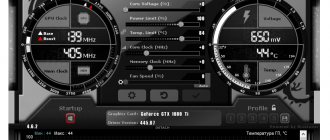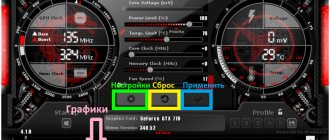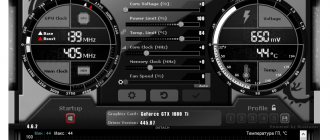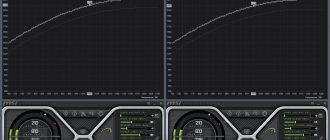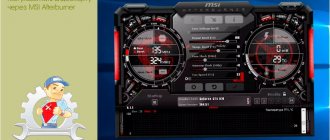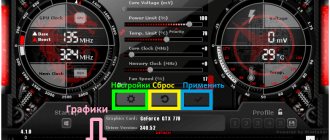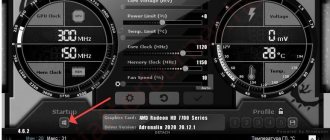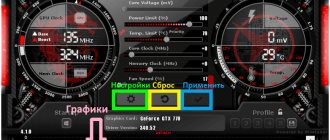MSI Afterburner is a proprietary application for managing the basic performance characteristics of discrete graphics accelerators from AMD and Nvidia. The program is used to overclock video cards by increasing the voltage and operating frequency of the graphics core and memory, and the fan spindle speed. It monitors the state of the graphics accelerator: temperature, frequency and voltage of the main power elements. In this article we will figure out how to unlock the Vcore Voltage parameter.
Problems with using MSI Afterburner arise when you need to change the voltage on the video card core - Core Voltage. The slider responsible for the voltage on the graphics accelerator core is set to minimum and is not active - it is colored gray. The problem is resolved quickly, but not on all computers.
How to Unlock Core Voltage in MSI Afterburner
From the MSI Afterburner context menu, select Run as administrator. Go to Settings > General and check the box next to Unlock voltage control. Now save the changes by clicking the Apply & OK buttons.
The changes you make will only be applied after you restart MSI Afterburner. In the window that opens, agree to restart the application. Now check if the Core Voltage value can be changed. The slider should now be available and active.
You can go to C:\Program Files (x86)\MSI Afterburner and find the MSIAfterburner.cfg file. Open the configuration file, for example, using the pre-installed Notepad program. See the best text editors for Windows 10.
In a text editor, change the value of line No. 35 or the UnlockVoltageControl parameter to 1. Completely close the MSI Afterburner program, if it was running, and open it. This may not work if the manufacturer has set a limit.
You also need to find the configuration file MSIAfterburner.cfg in the folder C:\ Program Files (x86)\ MSI Afterburner\ Profiles. Similarly, change the value of the UnlockVoltageControl parameter to 1. To save the changes, press Ctrl+S.
The Core Voltage parameter allows you to manually adjust the voltage on the GPU core. For security reasons, it is blocked in the MSI Afterburner program settings. Unqualified use of which can lead to irreversible consequences.
It can be unlocked directly in the settings of the program itself. Or if necessary in the configuration file using notepad
It is very important to completely restart the program to apply the changes. Then the Core Voltage slider will become active
Source
conclusions
Core Voltage is unlocked in MIS Afterburner in two ways: through the graphical interface and in the configuration file. If the PWM controller of the video card does not support power management, the function will remain unavailable in any case. And if you are wondering how much to set Vcore Voltage, then here you need to look for information on each video card separately and be very careful not to burn anything.
If you find an error, please select a piece of text and press Ctrl+Enter.
Related posts:
No related photos.
Rate this article:
( 6 ratings, average: 3.67 out of 5)
Tweet Pin It
about the author
immkg
2 comments
- Maxim 02.24.2021 Reply
It’s cool to see another article in the TOP of Google. - Someone 03/07/2021 Reply
By the way, unlocking Core Voltage enables the display of the CPU temperature in the monitor, if someone does not see it. Strange connection: CPU temperature is not displayed due to disabled graphics core voltage regulation).
Reduce intensity
Msi afterburner does not show monitoring
If you are using your main computer with the main video card in the motherboard to mine ETH, just add and do not use or - this will allow you to work on the computer relatively smoothly while the video card is mining.
Of course, the hashrate will be lower, otherwise you cannot have both a high hashrate and fast computer work.
If the computer still slows down, then you can extremely reduce the load on the video card. To do this, specify:
means that the card will only operate at 50% of its capacity.
Select the optimal values for your video card architectures. They all have different meanings.
Process
We will overclock using the MSI Afterburner utility. We do not need to enter the BIOS settings and change the voltage, as is done when overclocking the processor. Everything is done programmatically. If you are new to the interface and settings of the utility, we recommend reading the guide “How to use MSI Afterburner”.
The overclocking process itself is as follows: we gradually increase the load on the video card and see how this is reflected in games. If we suddenly notice artifacts or unstable operation, we immediately return to the previous parameters.
Special programs (3DMark, FurMark, Video Card Stability Test and others) are also suitable as testing tools. Plus, many players are pursuing the goal of achieving higher graphics quality in games that they run on low or medium settings. Therefore, productivity gains can be tracked there too. On average, it is 15-20%.
Efficient cooling
How to use msi afterburner and keep your video card in good shape
To activate manual variable change, click on the gear icon next to the Fan Speed slider.
Rice. 17 – Enabling manual cooler speed control mode
If you want the system to independently adjust the fan speed based on the current temperature of the video card, switch to automatic value control by clicking on the Auto icon.
Rice. 18 – Activate automatic fan speed control
In the “Cooler” settings section, you can specify the update frequency of the parameter and achieve maximum cooling efficiency, minimizing fan rattling.
Rice. 19 – Changing the period for updating data on the current fan speed
How to use MSI Afterburner
Correct configuration of the msi afterburner program
Before starting to work with the program, users need to be aware that if they do it incorrectly, the video card can become damaged. Therefore, you should strictly follow the instructions. Automatic overclocking mode is also undesirable.
MSI Afterburner supports NVIDIA and AMD video cards. If you have a different manufacturer, which is unlikely, you will not be able to use the tool. You can see the name of your card at the bottom of the program (highlighted in yellow).
Launching and setting up the program
We launch MSI Afterburner through the shortcut that was created on the desktop. We need to set the initial settings, without which many actions in the program will not be available. Check all the boxes that are visible in the screenshot. If your computer has two video cards, then add a checkbox to the “Synchronize settings of identical GPUs” field. Then click “OK”.
We will see a notification on the screen that the program needs to be restarted. Click “Yes”. There is no need to do anything else, the program will restart automatically.
Core Voltage
By default, the Core Voltage slider is locked. However, after we have set the basic settings (Tick in the voltage unlock field), it should start moving. If after restarting the program it is still not active, then this function is not supported by your video card model.
Core Clock and Memory Clock
The Core Clock slider adjusts the frequency of the video card. In order to start acceleration, you need to move it to the right. The regulator should be moved little by little, in increments of no more than 50 MHz
During the overclocking process, it is important to prevent the device from overheating. If the temperature rises above 90 degrees Celsius, the video adapter may break down
Next, we test our video card with a third-party program, for example, VideoTester. If everything is in order, you can repeat the procedure and move the regulator another 20-25 units. We do this until we see image defects on the screen
It is important here to identify the upper limit of the values. When it is determined, we reduce the frequency of units by 20 to eliminate defects
We do the same with Memory Clock.
To test the changes we have made, we can play some game with high requirements for the video card. In order to monitor the adapter's performance during the process, we configure the monitoring mode.
Monitoring
Go to “Settings-Monitoring”. Select the required indicator from the list, for example, “GP1 Load”. At the bottom, check the “Show in Overlay Screen Display” checkbox.
Next, we add one by one the remaining indicators that we will monitor. Additionally, you can configure the monitor display mode and hot keys. To do this, go to the “OED” tab.
Cooler setup
Please note that this feature is not available on all computers. If you decide to overclock the video card in new laptop or netbook models, you simply won’t see the cooler tab there. Although overclocking the graphics adapter on portable devices is generally not recommended.
For those who have this section, check the box next to “Enable software user mode”. The information will be displayed in the form of a graph, which shows the temperature of the video card at the bottom, and the cooler speed in the left column, which can be changed manually by moving the squares. Although this is not recommended.
Saving settings
At the final stage of overclocking the video card, we must save the settings made. To do this, click the “Save” icon and select one of 5 profiles. You also need to use the “Windows” button to launch new settings when the system starts.
Now go to the “Profiles” section and select your profile there in the “3D” line.
If necessary, you can save all 5 settings and load the one that suits each specific case. We'll leave it at that.
We are glad that we were able to help you solve the problem. Describe what didn't work for you.
Did this article help you?
- https://pomogaemkompu.temaretik.com/1162953515815668035/nastrojka-msi-afterburner—instruktsiya-po-nastrojke/
- https://mining-cryptocurrency.ru/nastrojka-msi-afterburner-dlya-majninga/
- https://lumpics.ru/instruction-on-using-the-program-msi-afterburner/
Video card is not supported by the program
The MSI Afterburner tool is designed only for overclocking AMD and NVIDIA . There is no point in trying to overclock others; the program simply will not see them.
It happens that cards are partially supported, that is, not all functions are available. It all depends on the technology of each specific product.
Thank the author and share the article on social networks.
MSI Afterburner is the most used utility for overclocking discrete graphics cards. It also provides detailed information about your computer's hardware components and offers additional features such as fan adjustment and performance testing. An interesting feature of the program is the ability to work with NVIDIA and AMD graphics cards from any manufacturer.
This article will tell you how to properly overclock your video card using MSI Afterburner. Before overclocking, you should decide whether the installed video card can be overclocked or not. It is worth noting that in addition to overclocking full-fledged discrete graphics, MSI Afterburner allows you to slightly overclock previous generation mobile graphics.
What is important to know and understand in the process
Next, to understand how to overclock a video card to the maximum, you need to know:
By “a little” we often mean not even tens, but units of MHz, and the peak overclocking value is achieved precisely due to these units, and the frequencies are interrelated, both in a good and in a bad sense; Overclocking (or rather overheating, increasing voltages and other related nuances) can damage the video card (and not only it) and/or reduce its service life;
No image distortions should appear anywhere and, ideally, never; Temperatures must be within normal limits, which is regulated by the appropriate slider and/or custom auto mode, which will automatically select the cooler rotation speed, depending on the temperature during overclocking and testing; It may turn out that the card is overclocked only by one of the parameters (i.e. only by memory or only by the processor), and when changing another parameter problems begin - this means that overclocking is possible only by this value, i.e. Core Clock (MHz) and Memory Clock (MHz), respectively; It is not recommended to touch other sliders at this stage (except, perhaps, “Power Limit”, and even then with caution), as this can significantly affect the life and operation of the video card.
Well, of course, it’s worth saying the following.
Questions and answers
Maxim Mazuta
I have overclocked 100,500 video cards and know a lot about optimal settings. You can ask your questions, I will help.
Ask a Question
We supplement the article with answers to your questions.
Questions to the expert
What damages a video card more – high or low voltage?
The device can operate unstably at both high and low voltage. At high voltage, the video card heats up more intensely, and under prolonged load or insufficient cooling it can fail due to overheating. Increased voltage accelerates the physical wear of power components, but in this case it should be neglected.
Why is the "curve editor" better than moving the slider?
When adjusting the frequency of a video card chip using the sliders, you cannot control the voltage, which is set automatically for the current frequency, which always leads to limits being reached and a constant “saw”:
MINUS: high consumption, high temperatures, drop in fps. PLUS: some synthetics “digest” this behavior and produce better results.
When adjusting the editor, you can always find a voltage at which the chip frequency will remain at one value and decrease only when certain temperature levels are exceeded:
MINUS: you need to spend some time finding the required voltage for the required frequency. PLUS: reduced consumption, lower temperatures, stable fps.
When working with a “curve,” there are cases when some of the frequencies after the fixed one remain at the top and, as a result, the voltage you fixed “does not work.” This can be leveled in two ways.
In most videos, this is done by initially lowering the entire “curve” and after setting the desired frequency/voltage:
The method I use (habit) is through “selection + Shift”: the entire area that is above the desired point is selected with Shift + LMB held down, then the Shift key is released and any point in the selection moves down, then click “apply” and everything goes back to normal into place:
Overclocking process
Card acceleration is often done using MSI Afterburner. This is a program designed to overclock a video card, which leads to improved performance of the computer and the game as a whole.
The peculiarity of the process is that you do not need to enter the system BIOS settings and change the voltage. The program will do everything, and the most important thing is to learn how to use it.
The process consists of several steps, each of which will be discussed in more detail below. The procedure is based on monitoring the state of the video card as it is loaded and changing the device parameters accordingly.
The first step is choosing settings
The first step is to launch the program. The initial screen will appear before your eyes. The next sequence of actions is as follows:
- You need to go to the menu. The menu looks like a gear on the top panel.
- In the column called “Selecting a leading GPU”, indicate the video card for overclocking. If you have two cards installed on your computer, you will need to click the checkbox to synchronize the settings of the same GPUs.
- After this you will need to check another box. It is placed in the “unlock voltage monitor” column.
- Then you need to go to the “Cooler” tab and turn on automatic mode. Only then will the program allow you to set the relationship between speed and temperature.
- Finally, the last action of the step will be to change the points on the graph that appears. The graph will precisely display the relationship between speed and temperature.
Replacing the video card driver version
There may be a conflict with the drivers for the video card and another version will be able to unlock the sliders - the old one or, on the contrary, the latest one. You can view the version in the Control Panel, section Administration - Computer Management - Device Manager (right-click on the video card - Properties - Driver).
After installing MSI Afterburner, users often observe that the sliders, which in theory should move, are at the minimum or maximum values and cannot be moved. This is perhaps the most common problem when working with this software. Let's figure out why the sliders in MSI Afterburner don't move?
Possible problems
to overclock a video card correctly using Problems may arise during the process. For example, manufacturers of some video cards pre-install a block on their devices that prevents acceleration.
To get rid of this block, you need to find the MSIAfterburner.cfg file and open it in Notepad. Next you will need:
- Find the line UnofficialOverclockingEULA.
- Write the following sentence after the “=” sign: I confirm that I am aware of unofficial overclocking limitations and fully understand that MSI will not provide me any support on it.
- In the window that appears, put one.
The sequence of actions presented above allows you to remove the blocking, but again, this does not work with all cards.
How to overclock a video card - step one
Stages:
- We slightly increase the Core Clock (MHz) value, leaving the Memory Clock (MHz) value the same;
- Click on the checkbox at the bottom right under the sliders;
- We launch a game/movie/special application for testing the load of video cards for a long time (at least an hour) and observe the temperature of the graphics processor, as well as image distortion (this also includes distortions in color, textures sticking out somewhere in games, and other “oddities”), as well as other oddities, such as game crashes, freezes, image updates (blinking), driver restarts (usually a notification appears), etc.;
- If everything went well and you did not see any of the above problems, then save the achieved value to the profile;
- We increase the Core Clock (MHz) value a little more, leaving the Memory Clock (MHz) value the same;
- We repeat all subsequent steps, increasing and maintaining the frequency until the operation ceases to be stable or the temperature is critical. When faced with a problem, we return to the last successful Core Clock (MHz) value and proceed to step two.
Go ahead.
What does the Power Limit option do?
Any video card has its own power consumption threshold (TDP). The higher it is, the more electrical energy is consumed per unit of time and the more heat is released. This is why more powerful video cards have higher power consumption and more powerful cooling systems are installed on them to remove the generated heat.
The Power Limit parameter allows you to increase or decrease the maximum power consumption of the video card. You need to increase it when overclocking, because in order to squeeze more out of the card than its standard capabilities, it needs to be given more power.
If the Power Limit is reduced, this will lead not only to a drop in the performance of the video card, but also to less heating. It’s no secret to many that the lower temperatures a video card operates at, the longer its service life.
How to use MSI Afterburner
Main features of the utility:
- Monitoring switching between 2D and 3D modes;
- Adjusting the voltage of the video memory chip and power supply of video cards;
- Graphics card cooling control;
- Monitoring FPS in games and displaying values on top of the screen;
- Recording the game process using the Predator video module.
After downloading MSI Afterburner, you need to unpack the archive and run the installation file. Then select the Russian language and accept the license agreement. Check the boxes for MSI Afterburner and RiverTuner Statistics Server and click “Next”.
Select the installation path (we recommend leaving the default one) and whether you need a shortcut on the desktop. For the RiverTuner Statistics Server interface, we leave the default language set - Russian, and complete the installation according to the same scheme.
The interface screen is divided into three parts:
- Video card and memory frequency sensors (GPU Clock and MEM Clock);
- Voltage and Temp values;
- Panel with sliders in the center.
At the top there are three buttons - launching the stress test of the MSI Kombustor utility, which must be additionally downloaded from the official website (also free), help on working with the program and information on the characteristics of the video card. Below the Fan Speed slider there is a settings menu button with a gear symbol. Next to it is the “Reset settings” option, designed to return the graphics card settings to their original state. On the right is the “Apply” button to approve the changes.
Is it worth overclocking your video card?
Overclocking or overclocking is a free way to increase the performance of key system components - processor, video card or RAM. Of course, successful overclocking requires suitable hardware and a little knowledge. Whether it is worth overclocking a video card should be decided by the user based on the state of the system and the set of components.
For those who like to play, there is often not enough video card capacity, which is responsible for processing heavy graphics of game engines. This results in a low frame rate or FPS, a jerky picture and other unpleasant things. Proper overclocking of the video card will help partially or even completely overcome them.
Important! Overclocking is the operation of a certain component beyond its standard, factory capabilities. The manufacturer does not guarantee a stable system state under overclocking. You also need to understand and take into account: overclocking increases the temperature and power consumption of the PC. Thus, before any intervention in a slow but stable system, you need to find out whether it is worth starting at all.
When overclocking a video card, the first thing you need to do is find out what kind of beast is installed inside. The free program TechPowerUp GPU-Z will help you find out everything very easily. Here you can see all the detailed specifications. model ( Name
), year of release (
Release date
), parameters of the graphics processor (
GPU, Technology, GPU clock
) and memory (
Memory type, Memory size, Bandw>).
Overclocking a video card for mining
Download the MSI Afterburner program from the manufacturer’s official website, install it, and launch it.
The program interface looks something like this:
The central part of the program contains the following sliders:
- Core Voltage
- Power Limit
- Temperature Limit
- Core Clock
- Memory Clock
- Fan Speed
Increasing memory frequency
To overclock my video card in order to increase performance when mining Ethereum, the RAM frequency slider (Memory Clock) is most important. Video cards can use memory from different manufacturers. The best option is SAMSUNG. This memory works stably even with strong overclocking.
Before starting active actions, we start the mining process. Moving the slider to the right should be done gradually in order to be able to observe performance and stability.
There is another approach - move in large sections at once and after the video card stops working, move downward from the too large value. At some point you will see a message:
Don’t panic, you haven’t done anything irreparable yet, but the video card can no longer work with the specified memory frequency. As a result, operation was stopped and the memory frequency was reset to standard. You should reduce your appetites and not set such a high value. Reduce it by a few percent and again observe the stability of operation.
The card I chose works stably at 2250 MHz, showing a result of 27.6 MH/s, that is, 12.7% more than before overclocking.
Reducing energy consumption
It may seem strange to newbies, but you can simultaneously increase processing power and reduce power consumption. This is possible due to the fact that the video card I selected (like other modern AMD devices) does not use graphics cores intensively when mining Ethereum. It becomes possible to reduce the core operating frequency without a noticeable decrease in performance, while the energy consumed will also become less.
Before starting this stage, the core frequency of my video card was 1340 MHz. Move the Core Clock slider to the left and watch the wattmeter readings and the number of megahashes decrease. I settled on 1150 MHz, while the power consumption of the stand with one video card decreased to 188 Watts, that is, by almost 22% compared to 240 Watts before overclocking. Computing power also dropped to 27 MH/s, which is less than 2% compared to the maximum values. Let me remind you that I am measuring the consumption of the entire stand, which has only one video card, while there are also other components of the farm. By overclocking all video cards in the farm at once, the energy savings will become even more noticeable. That is why, in practice, power supplies for mining farms are often used with less power than required by calculations.
Next, you can reduce the Core Voltage value, which will give an even tiny (by several Watts) reduction in power consumption.
We optimize the operation of the cooling system
By reducing energy consumption, we automatically reduced the heating level of the devices. Therefore, you can reconfigure the rotation speed of the cooling system fans.
MSI Afterburner allows you not only to unambiguously set this speed, but also to perform a more flexible setting by determining the dependence of the rotation speed on the temperature of the video card. To do this, you need to click on the gear-shaped button under the sliders, in the window that opens, go to the “Cooler” tab and move the graph points, thus building the desired dependence curve.
Choosing a fan speed is a compromise between the temperature of the video card, the noise level and the intensity of the cooler. At high operating speeds, the fan bearing will fail faster, but at low speeds, the video card will operate at high temperatures and there is also a risk of rapid failure. Repairing a cooler is generally easier than fixing a video card. The noise level also matters when placing a farm in a residential area.
After you have made all the necessary settings and are convinced that the farm is stable, you should save the configuration using the button in the form of a floppy disk (do young people know what this is?) on the right side of the MSI Afterburner interface.
Autostart MSI Afterburner
The final step is to configure MSI Afterburner to autostart when you turn on the farm. This is also done in the program settings, which can be opened by clicking on the gear button. On the “Basic” tab there is an item “Run with Windows”, it needs to be activated.
How to properly overclock a video card
All you need to do to successfully overclock a video card is to increase the frequency of the GPU and video memory using driver applications or other software. In this case, it is necessary to monitor the temperature and stability of the specified components.
First, you should find out the current state of things, that is, understand how stable the video card is before overclocking, what the frequencies and temperatures are. To do this, it is convenient to use stress test software, for example, you can use FurMark. It is with the help of the current program that you need to check the video card on your computer before purchasing.
In the main window we are greeted with the name of the graphic card (1) or cards (if your computer has several of them, the first one in order will be tested). It must match the model obtained in the GPU-Z utility. For the stress test, it is recommended to select a resolution (2) equal to the resolution of your monitor. After pressing the GPU stress test (3) and GO , the transition to testing mode will occur, where the video card will be fully loaded.
When a similar picture appears on the screen, you should pay attention to two sections with extremely useful information about passing the test. First of all, you need to look at the temperatures under load (2). Judging by the graph, you can see how the card gradually reached a maximum temperature of 75 C and stopped at this level. This temperature is quite acceptable and does not cause any concern.
Attention! If before overclocking, the temperature of the video card in this test is more than 80C, then there is a risk of overheating and instability after increasing the frequencies. Additionally, at elevated temperatures, the risk of GPU and memory failure increases, as does fan wear. And also if, after starting the test, the temperature graph suddenly rises above 90C, the test must be turned off (ESC key), since there are obvious problems with the cooling system.
The appearance of flickering, various distortions, lines, color changes or display blackouts and other abnormal effects indicate a malfunction of the video card, even if everything works fine in other applications or games. Overclocking such a card is categorically contraindicated in any case.
In section (1) you can track the main parameters of the test (resolution, anti-aliasing level) and the card under load (core, memory (3) and fan speeds, test time and the average number of frames per second (4) that the card can give at current frequencies. It is the average FPS that is needed to compare performance before and after overclocking, so you need to remember or write it down.
What does MSI Afterburner do?
The easiest way to understand what MSI Afterburner does is to break the utility's capabilities into categories.
Below are the main features that make up this software and exactly what they offer.
Overclocking
For many, overclocking is a challenging task that involves a fine line between better performance and hardware failure.
MSI recognizes this and has created its own overclocking utility in Afterburner that simplifies the process.
The overclocking feature provides precise settings that allow you to get the most out of your graphics card while protecting your hardware from permanent damage.
Clock speeds, core voltage, power limit
The software can adjust almost every aspect of the graphics card, including clock speeds, core voltage, power limiting, temperature limiting, memory clock speed, and fan speed.
Afterburner gives you all the tools you need to configure your GPU to your specifications, something other software applications don't offer.
To ensure that Afterburner works alongside all available graphics cards, it uses OC Scanner, a utility that uses an algorithm developed by Nvidia to detect any graphics card model (be it 960 or 2080 Ti).
Once the OC scanner detects which card you are using, it will set the highest and most stable overclock settings for that specific card.
It then applies the changes to your card for an immediate performance boost.
Fan control
Afterburner also allows users to fine-tune their fan profile, allowing you to select a custom fan speed curve that changes based on the temperature of your graphics card.
The higher the temperature, the faster the fan will rotate, the lower the temperature, the slower. It's quite simple.
All your overclocking profiles can be saved in the software and switched with the touch of a button.
Find the settings you need, save them and play!
Monitoring
Afterburner has a great monitoring feature that allows you to see the changes made to your graphics card and what's happening with every aspect of your graphics card.
The utility allows you to monitor everything from graphics card temperature, core and memory clock speeds, voltage, FPS and usage percentage through a series of graphs and full-screen display.
The screenshot also uses the Rivatuner statistics server, which can be pre-programmed for several different uses.
Monitoring GPU activity while games are running is an important part of benchmarking today, and the monitoring feature allows you to do this with FPS numbers and on-screen graphs
Benchmarking
What is Benchmarking?
Benchmarking is very popular among testers and enthusiasts today, especially now that there is so much competition around the graphics card industry. People want to know which card is better, and what better way to demonstrate that than in a fair, level playing field, benchmarking test. What is MSI Kombustor? MSI Afterburner includes a performance tool called MSI Kombustor that runs severe GPU stress processes to see how well your graphics card responds under load. This is a great way to see if your overclock settings have affected your graphics card's performance.
We'll take a closer look at how to use the software below.

